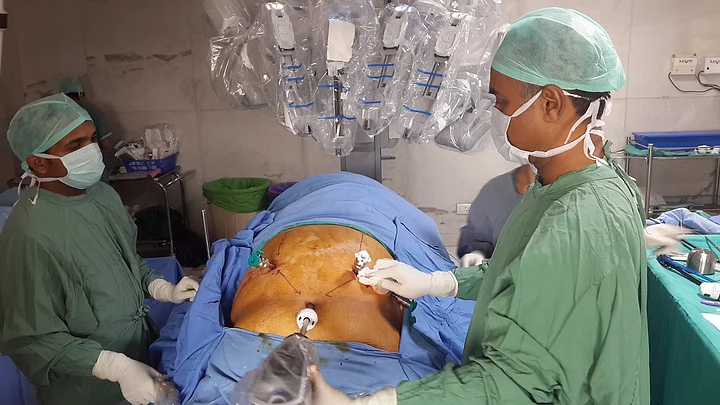Robotic-assisted surgery has much better postoperative outcomes, but its widespread adoption depends a lot on the reduction in the cost of the equipment, say experts.
While the high cost of a robot, which may range between Rs 6-14 crore approximately, may prevent many hospitals from bringing these advanced technologies for the benefit of patients, training of doctors in carrying out these procedures is equally important.
The US based-Vattikuti Foundation has helped prepare 300 robotic surgeons in India since 2011 by bringing in nearly 150 internationally acclaimed experts in the area to hold master classes, performing and observing live robotic surgeries in eight specialities.
“India has over 300 trained robotic surgeons in eight specialities -- gastrointestinal, urology, oncology, head and neck, thoracic, gynaecology, general surgery and bariatric,” Mahendra Bhandari, CEO, Vattikuti Foundation, says.
Patients in India are willingly opting for robotic surgeries for their treatments. Not only patients, young surgeons are leaving the old way (conventional surgeries) and they want to be a robotic orthopaedic surgeon nowMahendra Bhandari, CEO, Vattikuti Foundation
Robotic Surgeries Advanced, But Need to Be Cost-Efficient
Mahak Baid, an orthopaedic surgeon from Kolkata said that even though robotic-assisted surgery is an advancement, the only thing that needs to be worked upon is cost-effectiveness.
In a country like India, robotic surgery has to be economically viable. The robot itself costs a lot. So it is not just about the patients, it has to be economically feasible for the hospital as wellMahak Baid, orthopaedic surgeon
However, the doctor said robotic surgeries will eventually grow in India.
"I have been using MAKO robots for the last two years and I'm extremely happy with the results. we're able to do total hips, total knee and partial knee replacements. With robotics, we can do enhanced pre-planning much better than conventional methods," Thadi Mohan from Amrita Institute of Medical Sciences, Kerala, says.
"After the robotic surgeries, patients recover faster. Chances of revision become much less. Implants will last longer. There is also a change in the mindset of people as there are now a good number of trained surgeons," he said.
"The only thing holding back robotic-assisted surgeries in India are easy availability. It may take time but eventually it will become cheap and then more people will be able to use it," he stressed.
Bhandari urged global medical devices and pharma firms to bring their technology to the Indian market expeditiously so that the Indian patients do not have to wait for decades to be able to access the most advanced technology, drugs and implants.
When asked about the future of robotics in India, Brian Davis, Professor of Medical Robotics at Imperial College London told IANS that it cannot grow overnight.
"Many of Indian orthopaedic surgeons have been overseas and trained in countries where high-tech systems are quite normal, so they come in and act as mentor for junior Indian surgeons. So, it's gradually going to come about that you will have more and more experienced mentors but it's going to take a while," Davis added.
Many of the orthopaedic surgeons at the conference said that robotics-assisted bone replacement surgeries are far better and safer because of its consistency and precision than the conventional methods.
Joint replacement surgeons cited published studies that revealed that computer-assisted total knee arthroplasty leads to significantly lower blood loss, infections, inflammation and need for revision surgeries.
"The cost is major factor and rightly so. It takes years to develop this kind of technologies. So by the time they come in practice, the machine costs a lot. Naturally robotic companies with huge investment want to recover their money and India and other developing countries are not their priamary market, Bhandari said.
"The Vattikuti Foundation tries to bring these technologies once they are established. Our model is that we want to exploit the high volumes of the patients in low margins in order to make it cost-effective. And cost should not be major consideration while using a technology, cost is bound to come down the moment the technology used by more and more people," he said.
(Bharat Upadhyay attended the event at the invitation of Vattikuti Foundation. He can be contacted at bharat.u@ians.in)
(This story was published from a syndicated feed. No part of the story has been edited by FIT except the headline and the image.)
(At The Quint, we question everything. Play an active role in shaping our journalism by becoming a member today.)
